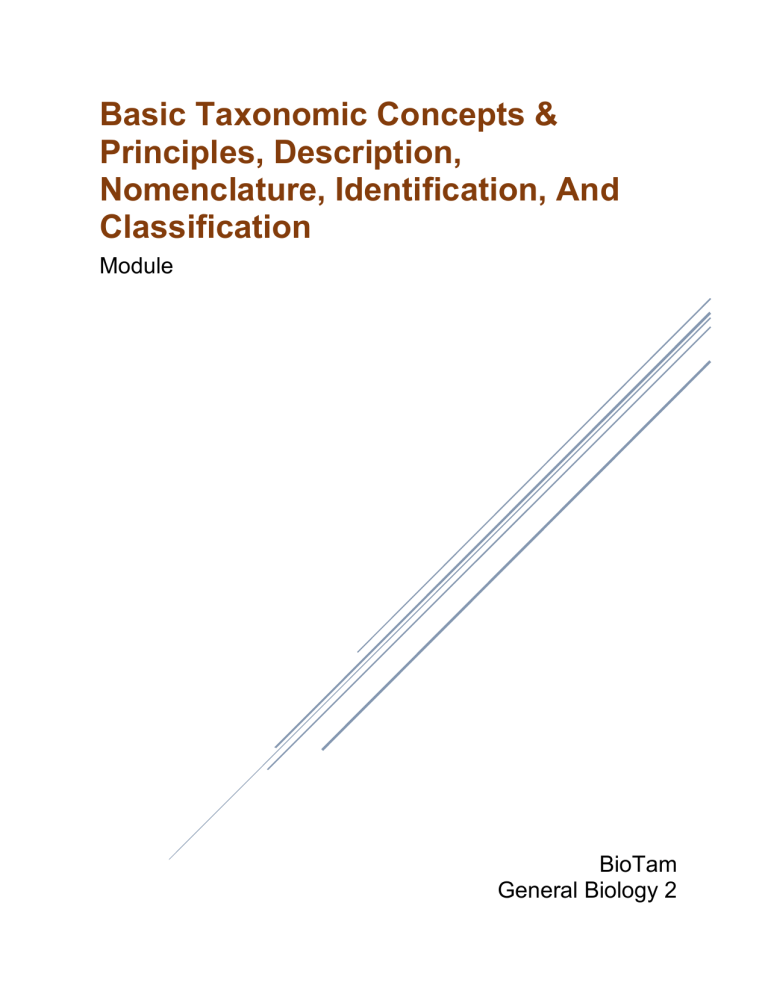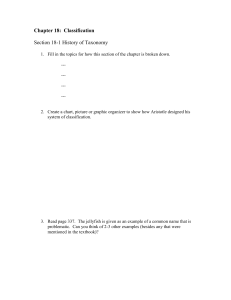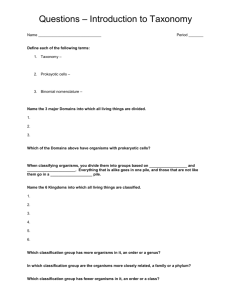
Basic Taxonomic Concepts & Principles, Description, Nomenclature, Identification, And Classification Module BioTam General Biology 2 Basic Taxonomic Concepts and Principles, Description, Nomenclature, Identification, and Classification OBJECTIVES This module entitled, “Basic Taxonomic Concepts and Principles, Description, Nomenclature, Identification, and Classification”, will elaborate your understanding and discuss about the evolutionary history of the biological diversity and achieve the following learning competencies: 1. Explain how the structural and developmental characteristics and relatedness of DNA sequences are used in classifying living things; 2. Identify the unique/distinctive characteristics of a specific taxon relative to other taxa; 3. Describe species diversity and cladistics, including the types of evidence and procedures that can be used to establish evolutionary relationships; and 4. Differentiate the 3-Domain Scheme from the 5-Kingdom Scheme of classification of living things. INTRODUCTION Did you know that animals and fungi are more closely related to each other than either of them is to plants? A phylogeny, the evolutionary history of a species or group of species, reveals and explains that the data from the DNA samples of animals – including humans – and fungi like mushrooms are most likely related despite of their difference in appearance. Figure 1.1 - Fungi, animals, and plants relationship 1|Page Basic Taxonomic Concepts and Principles, Description, Nomenclature, Identification, and Classification TAXONOMY Taxonomy is the science of classifying organisms. It results in classifications that allows storage, retrieval, and communication of information about organisms. Taxonomy is the branch of biology that groups and names organisms based on studies of their shared characteristics. DISCOVER Survey and inventory of existing collections DIAGNOSE Comparative morphology, and character discontinuity DESCRIBE Formal scientific destinction, and specimen and locality data NAME Scientific name, and publishing in scientific journal CLASSIFY Hierarchical classification, and biodiversity information portal Figure 1.2 – Taxonomic Methodology The method of taxonomy includes: the discovery of species, the recognition and diagnosing of taxa based on characters (e.g., morphological, molecular, behavioral, etc.), the formal description and naming of species, and the placement of species within a hierarchical classification. BINOMIAL NOMENCLATURE Do you want to know how species are being identified? In the early years of 1700s, Carolus Linnaeus have developed a system that classifies organisms based on their characteristics that is still used up to the present. He based the system on the physical and structural similarities of organisms. For example, plants are classified based on their flower structures which showed the shared characteristics of organisms. Linnaeus named the two-word naming system he developed, binomial nomenclature, which identifies specific species. Genus is the first word that defines a group of similar species. The second word, specific epithet, often describes the characteristic of the organism. For example, the species name 2|Page Basic Taxonomic Concepts and Principles, Description, Nomenclature, Identification, and Classification of humans in the present time is Homo sapiens, Homo from the genus where humans are specified and Sapiens which means ‘wise’ in Latin. TAXONOMIC GROUPS In Linnaean classification, species are placed in groups within more inclusive groups. Living organisms are divided into taxa (singular, taxon). The taxa range from having very broad characteristics into much more specific characteristics. KINGDOM ANIMALIA PHYLUM CHORDATA CLASS MAMMALIA ORDER CARNIVORA FAMILY PROCYONIDAE GENUS PROCYON SPECIES PROCYON LOTOR ORDER RODENTIA FAMILY CAVIIDAE GENUS CAVIA SPECIES CAVIA PORCELLUS Figure 1.3 – Raccoon and guinea pig classification 3|Page Basic Taxonomic Concepts and Principles, Description, Nomenclature, Identification, and Classification As you can see from Figure 1.3, a comparison between a raccoon and a guinea pig’s taxonomic groups, species is the most specific group. A genus is a group of similar species. A family is a taxon of similar genera. An order is a taxon of similar families. A class is a taxon of similar orders. A phylum is a taxon of similar classes, sometimes described as division. A kingdom is a taxon of similar phylum or phyla. Lastly, a domain is a taxon of similar kingdom. PHYLOGENETIC CLASSIFICATION: relationships determined?’ ‘How are evolutionary In phylogeny, evolutionary relationships are determined based on structural similarities, breeding behaviors, geographical distribution, chromosomes, and biochemistry. Structural similarities are the physical features that species have in common. Breeding behavior is used to compare species in a certain habitat. An example is how two groups of frogs have a difference in their mating behavior in a lake. An organism’s geographical distribution shows how a particular species is related to other species because of their ancestry. It tells us how the first specific species of an organism have evolved to different species because they moved to new environment through time which helped them adapt. Chromosome similarity is used to prove that two organisms that may not seem to look alike are related. Lastly, biochemistry is used to determine evolutionary relationships. Scientists study the DNA of species and find that closely related species have similar DNA sequences and, therefore, similar proteins. Sometimes these biochemical studies reveal that species once thought to be closely related are not. Molecular systematics is the discipline that uses data from DNA and other molecules to determine evolutionary relationships. 4|Page Basic Taxonomic Concepts and Principles, Description, Nomenclature, Identification, and Classification I. Morphology and Molecular Homology Homology is the phenotypic and genetic similarities due to shared ancestry. Morphological homology is the similarity of the internal structure of an organism to a common ancestor with the similar structure. On the other hand, molecular homology is how the genes or DNA sequences are homologous and descended from sequences brought by a common ancestor. Hence, organisms that has very similar morphological and molecular homology been likely to be more closely related than organisms that has vastly different structure or genes. Figure 1.4 – Lynx versus Bobcat. Even though lynxes and bobcats seem similar because of their appearances, they are very different in structure. For an instance, a lynx hips are higher than a bobcat’s, plus the lynx ear tufts is pointier and long. These have led to the conclusion that both species came from a common ancestor. II. Analogy vs. Homology Since homology identifies that species from a common ancestor is related because of their similar structures and DNA sequences – analogy, on the other hand, indicates that even though the organisms’ structures being studied looks similar, it does not mean they are closely related with each other. An example is how flying organisms like bats are identified as mammals, and birds are proven to be related to dinosaurs. Molecular homoplasy describes that even though two organisms’ have very similar DNA sequences bases, it does not mean that they are closely related. 5|Page Basic Taxonomic Concepts and Principles, Description, Nomenclature, Identification, and Classification You should know that to infer phylogeny, homology must be distinguished from analogy. CLADISTICS Cladistics is a method or system based on the classification system. Taxonomists who use cladistics assume that as groups of organisms evolve from a common ancestor, they keep a unique inherited trait. This is where scientists attempt to place species into groups, clades. Clades are nested within larger clades like taxonomic groups. However, a taxon is equivalent to a clade only if: It is monophyletic, which signifies that it consists of an ancestral species and all its descendants. It is paraphyletic, which consists of ancestral species and some, but not all, of its descendants. It is polyphyletic, which includes taxa with different ancestors. As a result of descent with modification, organisms both share characteristics with their ancestors and differ from them. A shared ancestral character is a trait originated in an ancestor of the taxon. However, a shared derived character is an evolutionary novelty unique to a clade. As an example, in mammals, backbone is a shared ancestral character because all mammals have backbone, but it does not distinguish them from vertebrates because the latter all have backbones. On the other hand, hair is a shared derived character because it is shared by all mammals but not found in their ancestors. Figure 1.5 – Shared ancestral and shared derived characters (mammals) 6|Page Basic Taxonomic Concepts and Principles, Description, Nomenclature, Identification, and Classification MOLECULAR CLOCK VS. NEUTRAL THEORY To determine the timing of molecular phylogenies that extend beyond the fossil record, biologists relied on the concept about how change occurs at a molecular level called molecular clock. The concept of molecular clock is a yardstick for measuring the absolute time of evolutionary change based on the observation that some genes and other region of genomes appear to evolve at constant rates. However, in the 1960s, several scientists independently published papers about neutral theory, which describes that much evolutionary change in genes and proteins has no effect on the fitness and therefore is not influenced by natural selection. FIVE-KINGDOM SCHEME VS. THREE-DOMAIN SCHEME Most of us know that early scientists classified organisms into two kingdoms: plants and animals. However, in the late 1960s, many biologists have organized and recognized a five (5) kingdom scheme. The 5 kingdoms consist of Monera (prokaryotes), Protista (unicellular organisms), Plantae, Fungi, and Animalia. This scheme highlighted the two fundamentally types of cell, prokaryotic and eukaryotic, and set the prokaryotes apart from all eukaryotes by placing them in their own kingdom, Monera. However, phylogenies based on genetic idea soon began to reveal a problem with this system: Some prokaryotes differ as much from each other as they do from eukaryotes. Such difficulties have led biologists to adopt a three (3) domain scheme. The three domains consist of: Bacteria, Archaea, and Eukarya. They are a taxonomic level higher than the kingdom level. The domain Bacteria contains most of the currently known prokaryotes, including the bacteria closely related to chloroplasts and mitochondria. 7|Page Basic Taxonomic Concepts and Principles, Description, Nomenclature, Identification, and Classification The second domain, Archaea, consists of a diverse group of prokaryotic organisms that inhabit a wide variety of environments. The third domain, Eukarya, consists of all the organisms that have cells containing true nuclei. This domain includes many groups of singlecelled organisms, as well as multicellular plants, fungi, and animals. The three-domain system highlights the fact that much of the history of life has been about single-celled organisms. The two prokaryotic domains consist entirely of single-celled organisms, and even in Eukarya, only the branches plants, fungi, and animals are dominated by multicellular organisms. Figure 1.6 – The three-domain system – Bacteria, Archaea, and Eukarya. Cain, M. L. (2011). Phylogeny and Tree of Life. In Campbell Biology (9th ed., p. 552). San Francisco, California: Pearson Benjamin Cummings. 8|Page Basic Taxonomic Concepts and Principles, Description, Nomenclature, Identification, and Classification REFERENCES: Cain, M. L. (2011). Phylogeny and Tree of Life. In Campbell Biology (9th ed., pp. 536-553). San Francisco, California: Pearson Benjamin Cummings. Glencoe. (2011). Organizing Life's Diversity. In Reading Essentials for Biology (pp. 184-193). Columbus, Ohio: The McGraw-Hill Companies. 9|Page




